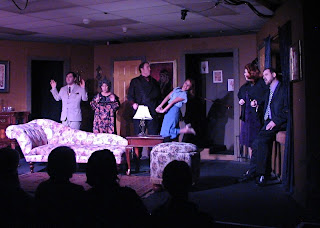I know – today’s song is from a film, not from a Broadway show, but c’mon. It’s Babs!
I just returned from a pioneer trek. The simple explanation – a church camping event for teenagers basically designed to teach them an appreciation for their religious heritage and to build friendships. My responsibility was to coordinate and facilitate musical events during the course of this 3 day experience. All in all, it went well. The same number came home (about 360) as left, so that’s a good thing.
With such a large group, in an outdoor settings, we needed amplification for most of the musical numbers. I was reminded of one of my soapbox speeches, so I decided to pull that particular one out for today’s blog. Since it’s a soapbox, it’s also a longer post than normal! It’s all about microphones. I am convinced that everyone should take a short course in using a mic. It isn’t hard, you don’t have to be a techie and you’re likely to have to know something about it at some point in your life, even if you aren’t involved in theater. Here’s my short course. If your eyes begin to glaze over, skip to the end. There won't be a test, at least until you have to grab a mic in order to be heard.
There are different types of microphones, designed for different purposes. Those used in a recording studio are generally not the type most people will encounter while giving a speech or singing for an audience. The handheld mics most people will use are called dymanic mics. While they tend to be a little more sturdy than other more sensitive microphones, there are still some basic rules for their care. Not dropping them is obvious, but hitting them to see if they are on is also a bad idea. It’s like hitting your child to see if he’s awake. Effective, but not smart. Blowing on them is also not good, although more of a problem for other types of mics. The best thing? Snap your fingers, talk into them (what a concept!) or scratch the windscreen (often a silver mesh covering). That way, you are making sounds that the mic will pick up, not inflicting abuse!
Many dynamic mics have switches. Think of it like a light switch. Up (toward your mouth as you hold it) is on, down is off. I don’t know how many times people have held a mic with the switch off and stood there hitting it while looking at me like I ought to be fixing something for them. Yeah, just turn on the switch.
There is also what is called a pickup pattern on a mic. It is the actual area around the microphone that will “hear” the sounds. Think of it like a flashlight. If you stand directly in front of a flashlight, it will illuminate you. If you stand off to the side a bit, you won’t be seen as well. If you’re behind it, you won’t be seen at all. Point that flashlight (microphone) directly toward your mouth, and you will be loudest. I have seen people hold them like a bridal bouquet somewhere near their belt, and they wonder why they can’t be heard. Certainly, some mics and some systems are more sensitive, but if in doubt, just get it closer to your mouth. There is a mathematical formula (it’s all physics) for the amplification versus distance from the source. Basically, it falls off noticeably each time you double the distance. So, 3 inches from your mouth is going to be louder than 6 inches, which is louder than 12 inches. If you hold it like a candle (completely vertical) in front of your mouth, it may still pick up your voice, but seldom as well as if you speak right down the throat of the mic. Be a rock star! Remember, the sound tech can always turn you down, but often cannot turn you up much higher without introducing other problems.
One common problem is feedback. Simply put, feedback is when the microphone “hears” the sound coming from the speaker, which it then tries to amplify, which then comes out of the speaker into the mic, which it then tries to amplify… Getting confused? Yeah, that’s why the speakers squeal in frustration. Try to remember not to place or hold a microphone where it will directly “hear” the sound coming from a speaker, and you should be fine. However, the higher you have to boost the microphone volume (to compensate for a small voice, or for not holding it close enough, etc.), the greater the chance that the mic will also “hear” the sound coming from the speaker. These are all reasons why you should keep the mic as close to the voice as possible, so only the voice is amplified and not extraneous sounds that can cause problems.
Body mics are another animal with their own set of woes, but usually work better on stage because they are so close to the performer. They also generally have a larger pickup pattern (think lantern instead of flashlight), which is why they can be placed on a cheek, at a hairline, or on a lapel and still work well. The biggest issues? Change batteries often and have fresh ones at the ready just in case, leave the pack turned on (don't mute it - you may forget to unmute it, and then you're sunk), be kind to the pack and cords (no dropping, kinking), and don’t place it where hair or clothing will brush the mic.
When you’re properly heard, no one thinks about the sound system. They only think about the performance. That’s as it should be - no technical distractions. Can you hear me now?









